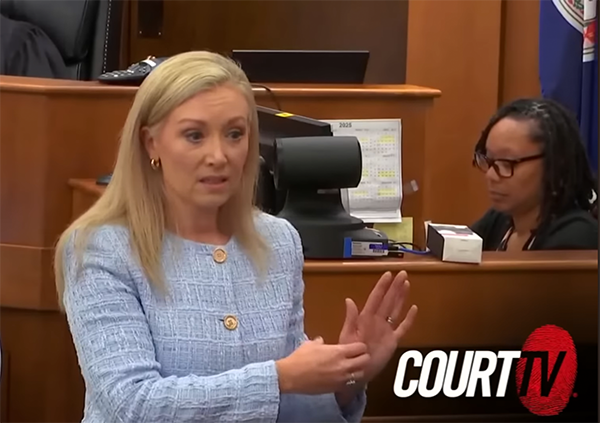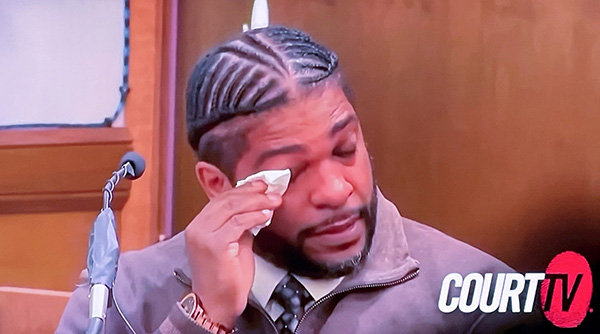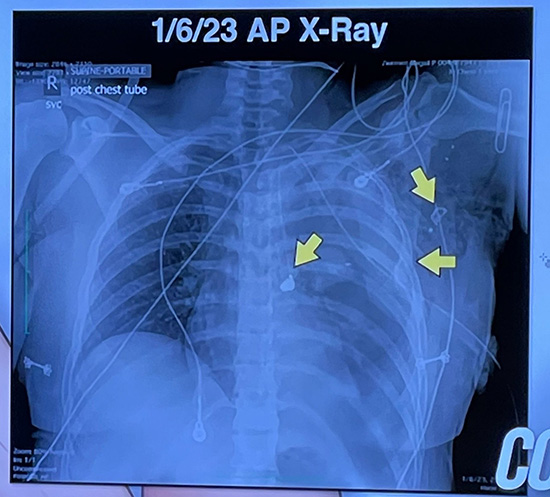On January 6, 2023, a 25-year-old white teacher named Abigail “Abby” Zwerner was shot by her six-year-old student in Newport News, Virginia. As a result, the child’s mother, a black woman named Deja Taylor, was sentenced to two years in prison for child neglect. Dr. Ebony Parker, the black assistant principal at Miss Zwerner’s school, has been charged with felony child neglect after a grand jury found that she ignored multiple warnings that the child had a gun. The grand jury also reported that the boy had allegedly choked his kindergarten teacher the year before and that the school’s files related to that incident were missing.

Abigail Zwerner, plaintiff
Dr. Parker’s criminal trial has not yet started, but a civil trial began on October 28 and is currently underway. Usually, when there are both criminal and civil trials for the same incident, the criminal trial is held first. Abigail Zwerner is suing Ebony Parker for $40 million, alleging that the school administrator’s negligence led to the shooting.
Opening statements
Diane P. Toscano, the lawyer representing Miss Zwerner, explained to the jury that Richneck Elementary School has a school handbook with a crisis management plan that gives the assistant principal the authority to search a student or to remove a student from the classroom if there is a safety threat. The assistant principal also has a duty to notify the principal and contact law enforcement.

Diane P. Toscano, attorney for plaintiff
Because of his age, the child who shot Abigail Zwerner is referred to in court by his initials, “JT.” Miss Toscano explained that a couple of days before the shooting, JT had grabbed Miss Zwerner’s phone and slammed it down, cracking the screen protector. He was suspended for one day but was back in school on January 6 “on a modified schedule,” which allowed his mother to drop him off an hour and a half later than the school’s normal start time. When JT arrived at school, he had a loaded gun in his backpack.
Assistant principal Ebony Parker, busy with some make-up testing, spent most of that day at her desk. First-grade teacher Abigail Zwerner went to Dr. Parker at 11:30 a.m. and told her, “JT seems off today, and in a violent mood.” She told Dr. Parker that he had just threatened to beat up a kindergartener. Dr. Parker did not even look up.

Dr. Ebony Parker, defendant
Shortly after noon, another teacher, Mrs. Kovac, went to Dr. Parker and said that she had just been in JT’s class, and she thought he might have a gun in his backpack. She said she was going to search it. When Mrs. Kovac returned to Dr. Parker’s office 20 minutes later, she told Dr. Parker she did not find a gun in the backpack but that Miss Zwerner said that JT had taken something out of his backpack and put it in his pocket.
Dr. Parker answered, “He has little pockets.”
Mrs. Kovack told Dr. Parker that JT was wearing a jacket.
At 1:40 p.m., the guidance counselor informed Dr. Parker that a student had seen a gun in JT’s pocket. He asked for permission to search JT, but Dr. Parker said that the boy’s mother would be arriving soon and that he should tell JT’s mother when she arrived.
At 1:58, Abigail Zwerner was shot. The bullet went through her hand and lodged in her chest. Miss Toscano explained to the jury that the bullet is still there because it is too dangerous to remove.
Miss Zwerner has since had six surgeries, and she will need another surgery on her hand, which she does not have full use of. The shooting has affected Miss Zwerner’s whole family; she needed round-the-clock care, requiring her twin sister to quit her job.
Miss Toscano told the jury that they would hear from witnesses that Dr. Parker violated protocol and put lives in danger by ignoring multiple reports that JT had a gun. “You’re going to hear that it was a six-year-old child. Who would think that a six-year-old is going to bring a gun to school and shoot his teacher? Members of the jury, it is Dr. Parker’s job to believe that that is possible. It’s her job to investigate it. . . . Her job is to address it.”
Ebony Parker’s defense attorney, a white man named Daniel P. Hogan, provided little insight his opening statements as to his client’s thought process on the day of the shooting. His main point was that “hindsight is 20/20,” and he told the jury, “It is fundamentally unfair to judge a person’s decisions based on stuff that we know after the fact.” One can, he said, disagree with Dr. Parker’s actions without finding that she was negligent.
Following are summaries of the testimony of some of the witnesses.
Dr. Nina Farrish, human resources director for Newport News Public Schools
Dr. Farrish interviewed Ebony Parker about the shooting two days later. Asked if she had known that a student had a weapon before the shooting, Dr. Parker said that had been reported to her, but that she did not know if the report was true. She knew that a teacher had searched the backpack but had not found a gun. Dr. Farrish said Dr. Parker herself had not searched JT’s backpack or pockets, had not informed the principal, and had not called 911.
Dr. Farrish then testified that the school’s “Threat Assessment Response Protocol” stresses that all threats be taken seriously and that any threat should be immediately reported to a school administrator. In addition, any student making a threat should be immediately removed from the classroom, and the administrator or school resource officer should call 911.
Rolonzo Rawles, school guidance counselor
Mr. Rawles testified that he had been informed that JT had told another first-grader, identified as R, that JT had bullets and would shoot R if he told anyone. Mr. Rawles, who had never before searched a student, asked Dr. Parker for permission to check JT’s pockets. Dr. Parker said that she wanted to wait until JT’s mother arrived. “I didn’t want to step over any boundaries,” he said, “so I wasn’t going to check him without permission.” He then told Miss Zwerner that Dr. Parker didn’t want him to check JT’s pockets and that she should let him know if she needed any more help.

Rolonzo Rawles tearfully describing the shooting
After the shooting, Mr. Rawles was in his office when the school intercom announced that the school was on lockdown. Leaving his office, he came across the janitor, who was mopping up blood from the floor. The janitor said, “They got him.”
Mr. Rawles asked, “They got who?”
Learning from a teacher that JT shot Miss Zwerner, Mr. Rawles went back to his office and cried. He said he felt “regret” and “guilt.” He had tried to help JT with his “anger management issues.” When he heard the rumor that JT had bullets, he thought that perhaps JT was just pretending they were bullets.
Under cross-examination, Mr. Rawles said that Dr. Parker had not refused to allow him to search JT; she just wanted to wait until the child’s mother was present. He also said that Miss Zwerner never sought his help with JT that day.
Jennifer West, teacher
Mrs. West is another first-grade teacher and a teammate of Miss Zwerner. Prior to the shooting, when the two were supervising recess on the school playground, Miss Zwerner had told her that she saw JT take something out of his backpack and put it in his coat. Mrs. West then watched JT and R through the remainder of recess. They would go behind a tree, R would walk away, and then they would came back together. After recess, Mrs. West asked R what was going on. He replied, “I can’t tell you. . . He said he would blow us up.” Assured that telling her was okay, R told her that JT had a gun and bullets. Asked what color the gun was, R cried and said, “It was bullet color.”
Mrs. West called the office to alert Dr. Parker and left a message with Mr. Sims, a teacher temporarily acting as receptionist. (Mr. Sims had testified earlier that he relayed the message to Dr. Parker.)
Mrs. West kept R in her classroom for the rest of the day, because he was “visibly scared” of JT. R kept getting up to look out the window by the door, across to Miss Zwerner’s class. Concluding that R had “seen something,” Mrs. West asked Mr. Rawles, the guidance counselor, to talk to him and suggested that JT’s pockets be searched. Mr. Rawles went to Dr. Parker, and then came back and told Mrs. West that they could not search JT.
When Mrs. West heard the gunshot, she knew it came from Miss Zwerner’s classroom. She went across the hall and saw Miss Zwerner’s hand was shot and she saw blood on the floor. Bringing all of the children from Miss Zwerner’s class into her own, she shut the door and followed the lockdown procedure. R was still in her room. She knew that something happened because of JT, but she didn’t see him.
The defense suggested that while many adults in the school had suspected JT had a gun, they were nonchalant about it. Video of Mrs. West and Miss Zwerner showed that when Miss Zwerner left the playground, she did not run off in alarm. Mrs. West just stood there watching, and did not separate JT from the other children. Mrs. West testified that during recess she knew JT was being sneaky with some sort of object, but “I wasn’t convinced it was a firearm until I spoke with R.”
Amy Kovac, reading specialist
Mrs. Kovac, a proctor for the makeup exams, was working closely with Dr. Parker on the day of the shooting. She recalled that when she left Dr. Parker’s office after a testing session, JT came out of the lunchroom and came over to give her a hug. Asked if he was having a good day, he happily said, “Yeah!”
She was back in Dr. Parker’s office when Miss Zwerner came in, and stood silently, waiting to catch Dr. Parker’s attention. Mrs. Kovac testified that Dr. Parker never acknowledged her. Eventually, Miss Zwerner spoke up anyway, telling Dr. Parker that JT threatened a kindergartener and “was aggressive with a security officer.” She then left to pick up her class.
Dr. Parker told Mrs. Kovac to tell Miss Zwerner that she could call JT’s mother “at any time to pick him up.”
When Mrs. Kovac was back in her own office, near Miss Zwerner’s classroom, two girls came out of the classroom and told her that JT had a gun in his bag. Inside the classroom, she saw that JT was “balled up in his seat,” which was not a normal posture for him. She told him what the girls had said and asked to see the bag.
JT refused, saying “No one is getting that bag,” using a tone that was “out of character” for him. Then he added, “People are picking on my friend R.”
Mrs. Kovac pressed on, “Do you have a gun in that bag?”
JT repeated, “No one is getting that bag.”
Meanwhile, Miss Zwerner, who had continued teaching her class, called the kids over to sit on a rug. Mrs. Kovac stayed in the room for a few minutes to observe JT. At one point, he asked her for scissors, but since they were not required for the lesson and because she worried he would do something dangerous, she refused.
Mrs. Kovac then went to Dr. Parker and informed her about the two girls and about what had happened when she sat with JT. Mrs. Kovac told the court, “I told her that when Abby’s gone off to recess, I would be back to check the bag.” She said Dr. Parker nodded her head at that.
Miss Zwerner sent Mrs. Kovac a text message, saying that they were outside for recess and that JT had taken something out of his backpack and put it into his jacket pocket. Mrs. Kovac went back to the classroom to check the backpack but found nothing unusual in it. She then returned to Dr. Parker and told her the bag was okay but that Miss Zwerner had reported seeing JT remove something from it and put it in his pocket.
Dr. Parker responded that JT “had little pockets.”
Mrs. Kovac emphasized that he put the item in his jacket pocket. “I was kind of mad,” she recalled, but still trusted that the administrator would handle the situation. “I reported that it was a gun,” Mrs. Kovac said, “The whole time, I assumed she [Dr. Parker] thought it was a gun.”
Asked by plaintiff’s attorney Toscano what the protocol was in such a situation, Mrs. Kovac said, “Report to an administrator.” Asked whom she reported it to, Mrs. Kovac said, “Dr. Ebony Parker. Several times.”
When later she heard the gunshot, Mrs. Kovac went straight into Miss Zwerner’s classroom. “I see blood on her leg, so I knew she was hit.” She went over to JT, as children were screaming and running away.
“He was standing there with his legs kind of spread out, arms crossed, and cocky. When I got to him, I didn’t say anything. I took his wrist because I knew he shot with his left hand. I walked to Abby’s desk, where the phone was. I put him in between my legs, put my arms around him, I picked up the phone to call 911. . . I said, ‘This is Richneck. A teacher’s been shot. I have the shooter. Send help.”
On cross examination, defense attorney Hogan showed the jury a text message that Mrs. Kovac wrote to Dr. Parker two days after the shooting. She wrote: “You are an amazing person and educator. No one could have ever predicted this.”
Dr. Alan Chap, trauma surgeon
Dr. Chap treated Miss Zwerner at the hospital, where her injuries were considered critical. When she was brought in, she had chest pain and trouble breathing. Her blood pressure was low, and she was not getting enough oxygen. A chest x-ray showed the bullet was very close to Miss Zwerner’s spine, close to “important structures” such as “nerves, bones, muscles and blood vessels.” Determining that it was too risky to remove the bullet, Dr. Chap used a tube to remove air and blood from Miss Zwerner’s chest and allow her collapsed lung to re-inflate. He brought in another surgeon to work on Miss Zwerner’s wounded hand.

X-ray showing entrance wounds and bullet still lodged in Miss Zwerner’s chest.
Julie Zwerner, mother of Abby Zwerner
Mrs. Zwerner, a former elementary school teacher herself, was the last plaintiff witness of the day. She showed the court a photo of her daughter graduating with her teaching degree and talked about how excited she had been about teaching, how she went to yard sales to find teaching materials, and how she put a lot of time into her lesson plans.
Mrs. Zwerner had been at work when the principal called to tell her, “Abby’s been shot.” Mrs. Zwerner began hyperventilating on the way to the hospital, not knowing if her daughter was alive. When she arrived at the hospital, she was told that Abby was in surgery, and she was allowed into the hospital sanctuary. When she finally saw her daughter, the injured young woman called her “Mommy,” the first time in many years she had called her anything but “Mom.”
After Miss Zwerner was released from the hospital, her mother had to take two weeks off from work to care for her. Abby Zwerner could do very little for herself because of her wounded hand. She could not open a bottle of medicine or remove a cap from a tube of toothpaste. She needed help to get dressed and to use the toilet. She could not take a shower for a month. There were many doctor appointments that Mrs. Zwerner had to drive her daughter to.
As of the trial, Miss Zwerner has recovered enough that she is able to drive, but her wounded hand is not healing well, so she will need another surgery. She wears a brace on the hand and needs occupational therapy to work on the fine motor skills that she has lost.
What’s more, Mrs. Zwerner has noticed changes in her daughter’s personality since the shooting: “She’s afraid a lot. Certain things scare her. Crowds. Going to certain places.” She talked about how the sound of a balloon popping at a baby shower had triggered Miss Zwerner’s trauma. Her daughter has become withdrawn, she said. When friends try to get in touch with her, she doesn’t respond. She has trouble getting out of bed, making decisions, and finding joy in things she used to like.
Her daughter’s sense of purpose is gone, because she feels she cannot face a return to teaching. Although she has earned a cosmetology license, she cannot make career plans while still in recovery and doesn’t know what she will be capable of. Mrs. Zwerner said, “Abby’s living from appointment to appointment, not really knowing what’s next.”
The defense tried to downplay her injuries by pointing to the fact that Miss Zwerner was able to graduate from cosmetology school. They tried also to make her look like she was capitalizing on the shooting by appearing on The Today Show and by having a GoFundMe page, which was set up by her sister.
* * *
It is a shame that the culture at this school prevented several adults from taking simple actions that could have prevented the shooting. Everyone at Richneck Elementary seemed to have been tiptoeing around a six-year-old. There were three white female teachers involved, a white male teacher who heard everything while operating the phones, a black male guidance counselor, and a black female assistant principal.
No one ordered JT to turn over his backpack or tried to take it from him. If someone had done this while the gun was still in the bag, Miss Zwerner might not have been shot. Mrs. Kovac had to sneak around and wait for JT to leave the backpack behind before she could search it. By that time, JT had been tipped off and had moved the gun to his jacket pocket. No adult was willing to order the boy to take his jacket off, and the school’s written policy gave only administrators the authority to separate JT from the other children or to investigate a possible threat. Dr. Parker’s lack of action allowed R to be threatened by JT and caused Miss Zwerner’s life to be forever changed by the shooting.
As a race realist, I wonder how much mistrust between different racial groups contributed to the policies that tied the teachers’ hands and created the kind of culture that made the adults at Richneck so ineffective. The white teachers must all know that if they make any wrong move around a black child, they will be publicly shamed, and their careers will be ruined. Were Ebony Parker and Rolonzo Rawles hesitant to deal with JT because of beliefs that black children need more leniency because of “systemic racism” in school systems?
Tomorrow, I will report on the second day of the trial.
The post Zwerner vs. Parker, Day One appeared first on American Renaissance.
American Renaissance



 R1
R1
 T1
T1


